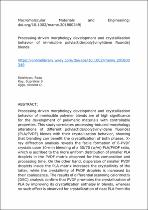 ResearchSpace
ResearchSpace
Processing-driven morphology development and crystallization behavior of immiscible polylactide/poly(vinylidene fluoride) blends
JavaScript is disabled for your browser. Some features of this site may not work without it.
- ResearchSpace
- →
- Research Publications/Outputs
- →
- Journal Articles
- →
- View Item
| dc.contributor.author |
Salehiyan, Reza

|
|
| dc.contributor.author |
Ray, Suprakas S

|
|
| dc.contributor.author |
Ojijo, Vincent O

|
|
| dc.date.accessioned | 2019-03-08T08:37:14Z | |
| dc.date.available | 2019-03-08T08:37:14Z | |
| dc.date.issued | 2018-08 | |
| dc.identifier.citation | Salehiyan, R., Ray, S.S. and Ojijo, V.O. 2018. Processing-driven morphology development and crystallization behavior of immiscible polylactide/poly(vinylidene fluoride) blends. Macromolecular Materials and Engineering: doi.org/10.1002/mame.201800349| | en_US |
| dc.identifier.issn | 1438-7492 | |
| dc.identifier.issn | 1439-2054 | |
| dc.identifier.uri | https://onlinelibrary.wiley.com/doi/abs/10.1002/mame.201800349 | |
| dc.identifier.uri | https://doi.org/10.1002/mame.201800349 | |
| dc.identifier.uri | http://hdl.handle.net/10204/10771 | |
| dc.description | Copyright: 2018 Wiley. Due to copyright restrictions, the attached PDF file only contains the abstract of the full text item. For access to the full text item, please consult the publisher's website: https://doi.org/10.1002/mame.201800349 | en_US |
| dc.description.abstract | Processing‐driven morphology development and crystallization behavior of immiscible polymer blends are of high significance for the development of polymeric materials with controllable properties. This study correlates processing‐induced morphology alterations of different polylactide/poly(vinylidene fluoride) (PLA/PVDF) blends with their crystallization behavior, showing that blending can benefit the crystallization of both phases. X‐ray diffraction analysis reveals the facile formation of β‐PVDF crystals upon 10‐min blending of a 30/70 (w/w) PLA/PVDF ratio, which is ascribed to the more uniform distribution of smaller PLA droplets in the PVDF matrix observed for this composition and processing time. On the other hand, dispersion of smaller PVDF droplets inside the PLA matrix increases the crystallinity of the latter, while the crystallinity of PVDF droplets is increased by their coalescence. The results of differential scanning calorimetry (DSC) analysis confirm that PVDF promotes the crystallization of PLA by improving its crystallization enthalpy in blends, whereas no such effect is observed for crystallization of neat PLA from the melt. Finally, nonisothermal DSC analysis of a 50/50 PLA/PVDF blend at different cooling rates reveals that slow crystallization results in enhanced blend crystallinity. | en_US |
| dc.language.iso | en | en_US |
| dc.publisher | Wiley | en_US |
| dc.relation.ispartofseries | Worklist;22060 | |
| dc.subject | Processing-driven morphology development | en_US |
| dc.subject | Polymer blends | en_US |
| dc.title | Processing-driven morphology development and crystallization behavior of immiscible polylactide/poly(vinylidene fluoride) blends | en_US |
| dc.type | Article | en_US |
| dc.identifier.apacitation | Salehiyan, R., Ray, S. S., & Ojijo, V. O. (2018). Processing-driven morphology development and crystallization behavior of immiscible polylactide/poly(vinylidene fluoride) blends. http://hdl.handle.net/10204/10771 | en_ZA |
| dc.identifier.chicagocitation | Salehiyan, Reza, Suprakas S Ray, and Vincent O Ojijo "Processing-driven morphology development and crystallization behavior of immiscible polylactide/poly(vinylidene fluoride) blends." (2018) http://hdl.handle.net/10204/10771 | en_ZA |
| dc.identifier.vancouvercitation | Salehiyan R, Ray SS, Ojijo VO. Processing-driven morphology development and crystallization behavior of immiscible polylactide/poly(vinylidene fluoride) blends. 2018; http://hdl.handle.net/10204/10771. | en_ZA |
| dc.identifier.ris | TY - Article AU - Salehiyan, Reza AU - Ray, Suprakas S AU - Ojijo, Vincent O AB - Processing‐driven morphology development and crystallization behavior of immiscible polymer blends are of high significance for the development of polymeric materials with controllable properties. This study correlates processing‐induced morphology alterations of different polylactide/poly(vinylidene fluoride) (PLA/PVDF) blends with their crystallization behavior, showing that blending can benefit the crystallization of both phases. X‐ray diffraction analysis reveals the facile formation of β‐PVDF crystals upon 10‐min blending of a 30/70 (w/w) PLA/PVDF ratio, which is ascribed to the more uniform distribution of smaller PLA droplets in the PVDF matrix observed for this composition and processing time. On the other hand, dispersion of smaller PVDF droplets inside the PLA matrix increases the crystallinity of the latter, while the crystallinity of PVDF droplets is increased by their coalescence. The results of differential scanning calorimetry (DSC) analysis confirm that PVDF promotes the crystallization of PLA by improving its crystallization enthalpy in blends, whereas no such effect is observed for crystallization of neat PLA from the melt. Finally, nonisothermal DSC analysis of a 50/50 PLA/PVDF blend at different cooling rates reveals that slow crystallization results in enhanced blend crystallinity. DA - 2018-08 DB - ResearchSpace DP - CSIR KW - Processing-driven morphology development KW - Polymer blends LK - https://researchspace.csir.co.za PY - 2018 SM - 1438-7492 SM - 1439-2054 T1 - Processing-driven morphology development and crystallization behavior of immiscible polylactide/poly(vinylidene fluoride) blends TI - Processing-driven morphology development and crystallization behavior of immiscible polylactide/poly(vinylidene fluoride) blends UR - http://hdl.handle.net/10204/10771 ER - | en_ZA |





